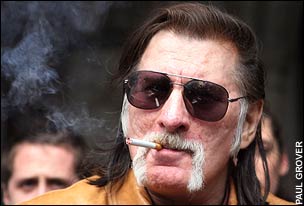|
FreePress-FreeSpeech Banner |
| Tyler | Inner Guard | Tracing Board | Middle Chamber | Holy Spirit Watch | Seek | 3° Tour | Keystone Kraft Koncepts | |
| Recently Initiated | Video and Audio Files | In Focus | The Morgan Report | F.·.W.·. Magazine | Mailroom | |
| Breaking Masonry News | Discussion Forum | Message Board | Blog | Guestbook | Books | Links | |
| Pillars of the Community | Travelling Men | Ancient Landmarks | Memory Work | |
| Anti-Masonry: Points of View | Craftyness | A Certain Point Within A Circle | |
|
FreePress-FreeSpeech Banner |




|
Telegraph Richard Leigh 30/11/2007 Richard Leigh, who has died aged 64, was a co-author of The Holy Blood and the Holy Grail, one of the most controversial books of the 1980s; in 2006, with Michael Baigent, he lost his plagiarism case against the American Dan Brown, author of The Da Vinci Code, the spectacularly successful thriller which they claimed was based on their book. Written by Leigh, Baigent and Henry Lincoln, The Holy Blood and the Holy Grail claimed to have uncovered a massive conspiracy to conceal a bloodline descended from Jesus of Nazareth that has influenced the course of European history. The protracted court case boosted sales of The Holy Blood and the Holy Grail, which had stalled at 3,500 copies a year in Britain, to 7,000 copies a week, a 100-fold rise. (Similarly, The Da Vinci Code returned to the bestseller lists with sales of 20,000 copies a week.) But against their royalties windfall, Leigh and Baigent - Lincoln took no part in the case - were left with a legal bill for their failed action of about £2 million. Originally published in January 1982, The Holy Blood and the Holy Grail achieved enormous commercial success; by last year it had reportedly sold two million copies. Richard Harris Leigh was born on August 16 1943 in New Jersey. His father was British, his mother Austrian. Leigh graduated from Tufts University in Boston and took a Master's degree at the University of Chicago before studying for a doctorate in Comparative Literature at the State University of New York in Stony Brook. He spent several years working as a university lecturer in the United States, Canada and Britain. In 1975, at a summer school in England where he was lecturing on aspects of literature, Leigh met the writer Henry Lincoln and discovered that they shared an interest in the order of medieval warrior-monks known as the Knights Templar. Lincoln had already started researching the strange story of an obscure 19th-century French country priest, Bérenger Saunière, who had apparently been able to spend huge sums of money in the years around 1900, refurbishing his parish church in the remote Languedoc village of Rennes-le-Château in the foothills of the Pyrenees. In Leigh, Lincoln found a sympathetic and knowledgeable fellow-traveller. When Leigh offered to help Lincoln with studying the Templars he recruited Michael Bagient, a psychology graduate who was researching the shadowy order for a film project. Between them Leigh, Lincoln and Baigent developed the Saunière story into a full-blown hypothesis: that Saunière had stumbled on a sensational secret. This was that Jesus had not died on the Cross but had married Mary Magdalene and fathered at least one child; his descendants, they suggested, continue to exert an influence on European history through the Prieuré de Sion, a secret society originally founded in Jerusalem during the First Crusade. In a follow-up book, The Messianic Legacy (1986), Leigh and his co-authors claimed that the then Grand Master of the Prieuré, Pierre Plantard de Saint Clair, was seeking to restore the Merovingian dynasty to rule France while also taking on a monarchic role in the running of the European Union. It was later proved that Plantard had made up the Prieuré as a hoax in 1956. Further collaborations with Michael Baigent included The Dead Sea Scrolls Deception, alleging a Roman Catholic conspiracy to conceal the scrolls, and The Temple and the Lodge, a history of Freemasonry (both 1991); Secret Germany (1994), the story of a plot to kill Hitler; The Elixir and the Stone (1997); and The Inquisition (1999). Although best-known for his non-fiction work, Leigh preferred to think of himself as a writer of literary fiction. In Erceldoune & Other Stories (2006) he included an essay on "Ireland, Mythic Logic", which explored the forces at work where the country's past, present and future intersect. His last novel, Grey Magic, published this year, was semi-autobiographical, the narrator and protagonist being born in the United States but moving to Britain in his early thirties. Richard Leigh, who died on November 21, was unmarried. |

